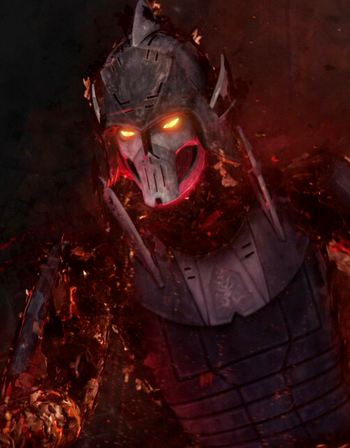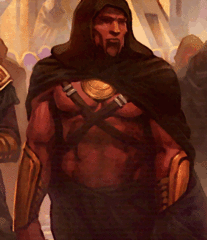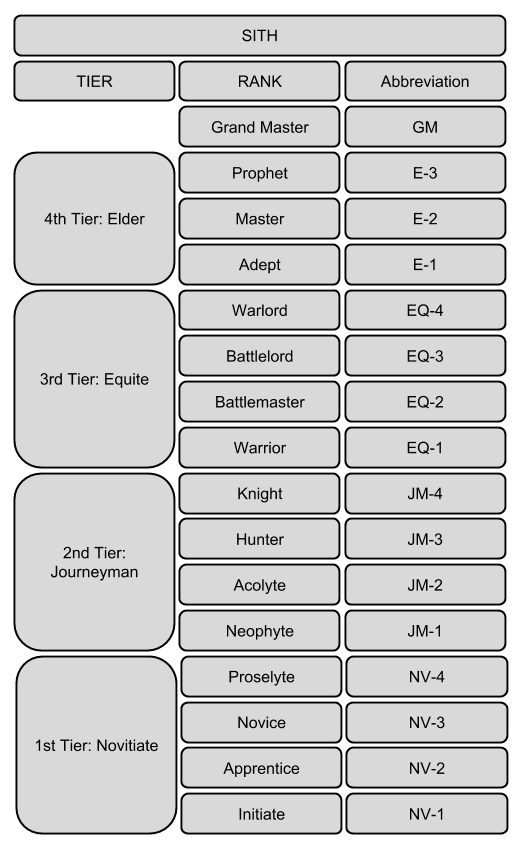Sith Order Core
1. Introduction
The Sith Order has a long and storied past, existing long before the Dark Jedi Brotherhood came into existence. This course should serve as an introduction to the history of the Sith before the Brotherhood and give you an understanding of the modern Sith.
2. History of the Sith
2.1 Pre-Brotherhood History
The origins of the Sith Order itself are a lingering mystery, mainly due to the fact that the earliest historical records were likely destroyed in one battle or another. From what scraps of information historians have been able to cobble together, there were countless reiterations of the origins; some believe that the Sith themselves were an ancient species of bipedal sentients that were enslaved and corrupted by the first fallen Jedi, countless millennia before the formation of the Old Republic. Others, however, hold the belief that the Sith held a great Empire and shared their secrets to power to those who earned their trust before the species fell to extinction.
Here, we meander into the definitive histories and leave such speculation behind. Unfortunately, parts of these files were corrupted prior to or damaged when Darth Vader and the 501st marched on the Jedi Temple on Coruscant. As such, some of the information is incomplete.
The earliest mentions of the Sith, ironically enough, were discovered within the archives of the Jedi Order. Thousands of years prior to the Clone Wars, those who would form the Sith and the Jedi Orders were considered brothers and sisters within the Force. This unity was fractured when a rogue Jedi, whose name and gender are unknown, decided that true mastery of the Force came not from contemplation and tranquility, but by tapping into the Dark Side of the Force. When this Force User delivered his thoughts before the Jedi Council, the rogue Jedi was cast out. Though damaged, the context indicates that the outcast had convinced others of the power that could be gained. These former Jedi and those who they recruited to their cause chose to form a new order.
This period in time later became known as the Hundred-Year Darkness and serves as the birth of the Sith Order as we know it today. Their quest for knowledge and greater power sparked a civil war between the two factions, which ended with the defeat of the burgeoning Sith Order. The survivors traveled from known space and settled on a planet to rebuild in secret. This planet is now known as Moraband.
It was on this planet that the Sith thrived. The Dark Lord of the Sith was established as the ruler, and the Sith built temples and tombs on the backs of their slaves, many of whom were said to be natives of the planet. Throughout the ages, the Dark Lords of the Sith established various empires that either fell from within or subjugated other systems as they battled the Jedi Order for control of the galaxy. This continued for some time, with the Sith establishing temples or shrines of concentrated dark power, such as the one on Malachor that is considered a forbidden world to the Jedi.
However, roughly a thousand years prior to the Clone Wars, in a period known as the Dark Age, the Sith were wiped out after they started vying amongst themselves for power while also in conflict with the Jedi. One Sith, however, survived and re-shaped the Order with all of the others gone. Realizing that a vast empire bred infighting and that the Jedi would not be defeated for good through open warfare, he took on the mantle of Dark Lord of the Sith and established the Rule of Two. This Sith was known as Darth Bane.

Bane trained an apprentice in the new philosophy - to seek their revenge through cunning and subterfuge. When the Jedi learned of his existence, Darth Bane was hunted down and killed. Believing that Bane’s death brought the Sith Order to extinction, the Jedi Order returned to their practices of contemplation and tranquility, unaware of the existence of Bane’s apprentice, who continued his plans. After entombing the man who established the Rule of Two on Moraband, the planet was abandoned, though his new tradition was carried out for generations in absolute secrecy.
While the Jedi Order grew complacent, serving as the peacekeepers of the Galactic Republic, the Sith plotted and evolved through the centuries, perfecting their plan for revenge. It would take nearly a thousand years after his death for Darth Bane’s plan to play out.
It started with the death of Darth Plagueis the Wise, when his apprentice took on the mantle of Dark Lord of the Sith by murdering his master in his sleep. Through a series of carefully orchestrated events known as the Naboo Crisis, Darth Sidious’ public persona was voted in as Supreme Chancellor of the Galactic Republic. Though most would have taken this opportunity and enacted a half-baked gambit, Darth Sidious was patient and cunning. The sacrifice of his apprentice, a Dathomirian male that was given the name Darth Maul, served as bait for the Jedi Order to reveal that the Sith had not died out as they once believed. It took another ten years of careful plotting as Sidious further baited and built the trap.
During this time, Sidious sank his hooks into a disillusioned Jedi Master. Enticed with promises of a better future and a government free of the corruption that had disgusted Dooku, the former student of Yoda left the Order and became Sidious’ new apprentice, Darth Tyranus. Dooku, now a Sith, reclaimed his title as Count of Serenno and started the movement that became the Confederacy of Independent Systems.
The Clone Wars themselves were a series of masterful plays through an elaborate game of chess with the malevolent figure of Sidious playing both sides. His own beloved public image as Chancellor Palpatine on the side of the Republic, whilst Count Dooku was the leader of the Separatists. Through the Clone Wars, Darth Sidious had the Jedi Order whittled down to almost nothing and continued to have himself granted emergency war powers. The Dark Lord of the Sith saw the plots were coming to a head and sacrificed Dooku, his figurehead for the Separatist movement, to ensnare his new apprentice. Within a matter of weeks following Dooku’s death and the tightening of the web around his new apprentice, Sidious sprang the trap. He allowed the young Jedi Knight he had seduced to report that he was, in fact, the Dark Lord of the Sith to the Jedi Council.

His own manipulations bore fruit when the last of the Jedi Masters who had arrived to arrest or eliminate him was disarmed at the hands of Anakin Skywalker. Thus, Darth Vader was born. At Sidious’ order to the Clone Army — Order 66 — Jedi died at the hands of their trusted comrades. Darth Vader, alongside the elite Commandos of the 501st, stormed the Jedi Temple and eliminated everyone living within. With the Jedi declared traitors to the Republic for the attempted assassination of the Chancellor, Sidious led the vote that the Republic was weak and they should become strong. Through thunderous applause, the Galactic Empire was born with Sidious at its head for the duration of his life.
The revenge of the Sith and centuries of patient planning was complete. Only a few Jedi remained in the galaxy, and those few who tried to make a stand were quickly cut down. The Sith ruled the galaxy with an iron fist, though in less than twenty years, Emperor Palpatine was dead. Anakin Skywalker, redeemed by his son Luke, threw the Dark Lord of the Sith into the reactor chasm of the second Death Star and died shortly thereafter.
2.2 Brotherhood History

The history of the Sith within the Dark Jedi Brotherhood begins with a member of the Sith known as Okemi, a Sith Lord who lived approximately five thousand years ago. He was an influential member of a powerful Sith Empire who unsuccessfully rose up against the Sith establishment and was banished for his trouble. He fled Ziost, the capital of the Sith Empire at the time, and eventually landed upon Antei, where he set himself up as a God-King.
Okemi and his two closest confidants and advisers -- the sorceress Tiamat and an assassin named Ferran -- performed a Force ritual to achieve immortality. Okemi and Tiamat began a ritual to harness the power of Ante, the sun of the Antei system. Ferran, who had been opposed to the plan from the beginning, plunged his sword into Tiamat’s heart, stopping the ritual and killing both Tiamat and Ferran. It also caused the “Obscuration,” the event that turned Ante into a black dwarf star and devastated the rest of the Antei system in the process.
The Sith Order in the Brotherhood was modeled, in part, on Okemi: the Sith constantly seek to attain power through positions of authority within the Brotherhood and to subjugate their rivals. True to this dictate, the majority of the various positions of leadership in the Brotherhood at all levels were historically held by members of the Sith Order. However, over time, the Grand Masters, principally Muz Ashen and Darth Pravus, saw wisdom in extending the reach of the Brotherhood to other Orders -- even to the Jedi. Under their leadership, the ranks of Light and Gray Path adherents grew, and the power of the Sith correspondingly diminished. Some Sith see this as betrayal, though others view it as an opportunity to rule through figureheads. Most Sith have accepted the new status quo and will strive to use it to their advantage, as the Sith always have.

In the Brotherhood, the Sith do not strictly adhere to the “Rule of Two” created by Darth Bane. Instead, the Brotherhood’s Sith form loose bonds of master-student relationships, with one master often training many apprentices over a lifetime. Those apprentices who survive then often take on apprentices of their own, and likely share some oath of fealty to their over-master. This structure works because so many masters have trained so many apprentices, yet they all bow to the Dark Lord of the Sith. There are enough internal and external forces threatening the Brotherhood to prevent any one Sith from breaking the balance and thrusting the Order into chaos.
3. Philosophy
The Sith practice violence, deceit, and betrayal, all in service to self-preservation and advancement. For millennia, the Sith Order has followed the Sith Code:
Peace is a lie, there is only passion.
Through passion, I gain strength.
Through strength, I gain power.
Through power, I gain victory.
Through victory, my chains are broken.
The Force shall free me.
-- The Sith Code
In the Brotherhood, the Sith have no formal Order leader. The Grand Master of the Dark Jedi Brotherhood has always been bestowed the title “Dark Lord of the Sith,” but the Grand Master’s concerns reach far beyond the politics of the Sith Order, and so individual Sith are usually left to chart their own courses.
4. Ranks of the Sith Order

5. Conclusion
This course, though brief, should have provided you with enough knowledge to discern whether the Sith path is the right choice for your character or whether you’ll chart a different course - armed with at least a fundamental understanding of one of the dominant forces within the Brotherhood. Should you seek to further your knowledge, seek out the courses on the Sith and their role in Galactic History within the Hall of Legends.
Please log in to take this course's exam